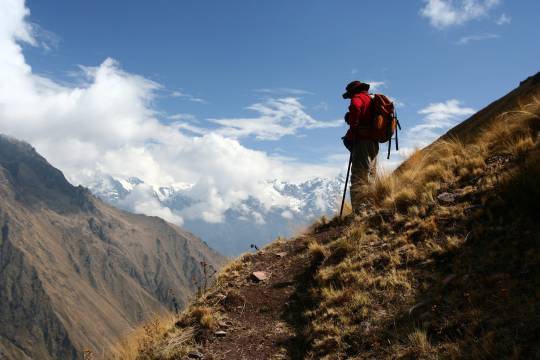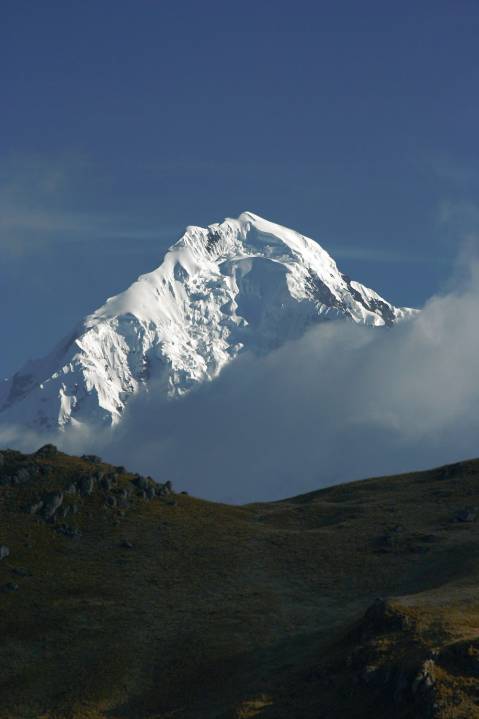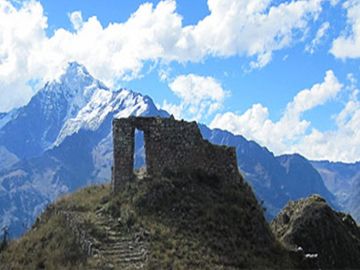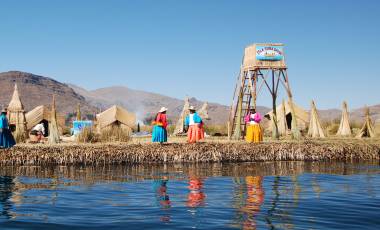Read time – 3 minutes
Trekking the Inca Trail to Machu Picchu is rightly considered to be the most iconic walk in Latin America and many of you will have completed the four-day, 35km hike.
However, there is another (and in my opinion, better) way to reach the fabled ruins: the Moonstone Route.
 Views on the Moonstone trek
Views on the Moonstone trek
Reasons to take the Moonstone Route
When I embarked on this off-the-beaten-track trek in May, I didn’t see another tourist for the entire four days. I explored Inca ruins recently excavated from the claws of nature, crossed a pass of 4,600 metres and marvelled at the imposing scale of Mt Veronica. This is real discovery travel.
Starting out at the ‘Moonstone’ – an intricately carved boulder sat among other distinct Inca remnants – there was poignancy to the solitude here. No unwelcome bumbags edging into my photos and no dollar-hungry stalls laden with ‘souvenirs’. This was a refreshing theme over the next four days.
Day 1
The target for the first day was to reach the mysterious pre-Inca fortress of Wata. Sitting at 3,800 metres, the effects of the altitude were really starting to kick in. Lunch was a welcome relief.
It was during this well-earned pit stop that I learnt about Pachamama. A tradition revered by the indigenous people of the Andes, it is important to toast this Mother Earth goddess before eating or drinking by offering her some of your bounties. Simply spill a little chicha on the ground before gulping down the remainder of this tasty beverage and your challa is complete.
Onwards to our first camp, we were accompanied by a group of excitable local children fascinated by the sight of European faces passing through their tranquil mountain hamlet. Despite being just 40km from the melting pot of The North Face, Canon and other consumables that engulf Machu Picchu, these children were genuinely intrigued at our arrival.
 Peaks on the Moonstone Trek
Peaks on the Moonstone Trek
Day Two
Day two offers some of the best views of the trip. Reaching the highest point of the trek, the Huayanay Range, the Urubamba Range and the triangular Mt Veronica all come into play. It also serves up some of the best grub.
After digging a hole and getting a fire going, we wrapped up a few potatoes, a big beef joint and then buried the lot! This was cooking using resources to hand and the ultimate homage to Pachamama. An hour and a half later, we donned our head torches, found our heap of earth, and got digging.
After carefully unwrapping the food, we enjoyed the fruits of our labour. It was quite simply the best meal I had in Peru, and all under a clear, star-studded night sky. No fires are allowed on the traditional Inca Trail.
Day Three
Edging carefully through a narrow gorge following an ancient Inca aqueduct, day three culminated at a campsite beside an Inca burial site. Taking a peek inside the chambers revealed several skeletons. These had not been protected, adjusted to be on display, or even removed by a national museum or some wannabe explorer. They were just there, as they had been for the last 500 years and they would be our company for the last night of this trek.
With this in mind, I was pleased a local had walked up from Ollantaytambo with a bevvy of Cusquena beers, a sign we were approaching civilisation and the hunt for the tourist dollar was back on. However, my trekking companions and I knew we had experienced something very special and unique as we toasted a successful trek. Not before offering a drop to Pachamama of course!
Do this trek, you won’t be disappointed and you will still get a full day to enjoy the famous, well photographed and ever-popular Machu Picchu, you just get there a different, lesser travelled way!
No permit is required for the Moonstone Trek, so even when all the Inca Trail permits have sold out (which is always very soon after they’re released), the good news is you can still enjoy some classic high Andean trekking and see the mighty Machu Picchu.
Find more Inca Trail trips below and make your own mind up about which route to take.







